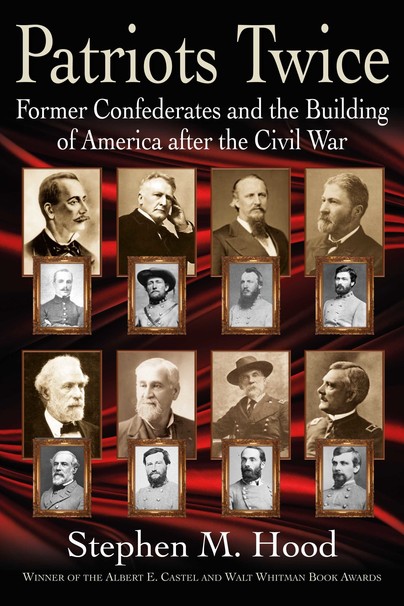
Pages: 288
ISBN: 9781611215151
Pub Date: November 2020
Imprint: Savas Beatie
Illustrations: 1 map, 90 images
Price:
£27.99
In stock
Pages: 256
ISBN: 9781611217513
Pub Date: January 2025
Imprint: Savas Beatie
Price:
£18.99
Usually available in 6-8 weeks
Description:
The Civil War was a long and bloody affair that claimed the life of some 750,000 men. When it ended, former opponents worked to rebuild their common country - America - and move into the future together. Most modern Americans might find that hard to believe, especially in an era witnessing the tearing down or movement of Confederate monuments and desecration of cemeteries. In the unique and timely Patriots Twice: Former Confederates and the Building of America after the Civil War, award-winning author Stephen M. Hood identifies more than 200 former Confederate soldiers, sailors, and government officials who reintegrated into American society and attained positions of authority and influence in the Federal government, United States military, academia, science, commerce, and industry. Their contributions had a long-lasting and positive influence on the country we have today. Many of the facts and stories in Patriots Twice will come as a surprise to modern Americans. For example, ten postwar presidents appointed former Confederates to serve the reunited nation as Supreme Court justices, secretaries of the US Navy, attorneys general, and a secretary of the interior. Dozens of former Southern soldiers were named US ambassadors and consuls. Eight were appointed generals who commanded US Army troops during the Spanish-American War. Former Confederates were elected mayors of such unlikely cities as Los Angeles, CA, Minneapolis, MN, Ogden, UT, and Santa Fe, NM, and served as governors of the non-Confederate states and territories of Colorado, West Virginia, Missouri, Utah, Oklahoma, New Mexico, Alaska, and the Panama Canal Zone. Former Confederates became presidents of national professional societies, including the American Bar Association, the American Medical Association, the American Gynecological and Obstetrical Society, the American Neurological Association, the American Surgical Association, and the American Public Health Association. In science and engineering, former Confederates led the American Society of Civil Engineers, the American Chemical Society, the American Association for the Advancement of Science, and the Geological Society of America. One former Confederate co-founded the environmental and preservation advocacy group Sierra Club, and another intellectual and scholar was president of the Society for Classical Studies (at that time named the American Philological Association). Many former Confederates founded or co-founded many our nation’s colleges and universities, some exclusively for women and newly freed African-Americans. Other former rebels served as presidents of prominent institutions including the University of California, Berkeley. Others taught at universities, not just in the American South but at Harvard, Yale, the University of Wisconsin-Madison, Johns Hopkins, the University of San Francisco, and Amherst College. Many others served on the governing boards of the United States Military Academy at West Point and the United States Naval Academy at Annapolis, Maryland. Today’s United States benefitted greatly from the post-Civil War reconciliation that accepted the contributions of former Confederates. The men who fought the South forgave them and moved on together. It’s an important lesson everyone today should learn.
The long and bloody American Civil War claimed the lives of more than 700,000 men. When it ended, former opponents worked to rebuild their reunified nation and moved into the future together. Many people will find that hard to believe—especially in an era witnessing the destruction or removal of Confederate monuments and the desecration of Confederate cemeteries.In the unique and timely Patriots Twice: Former Confederates and the Building of America after the Civil War, now available in paperback, award-winning author Stephen M. Hood identifies more than three hundred former Confederate soldiers, sailors, and government officials who reintegrated into American society and attained positions of authority and influence in the federal government, the United States military, academia, science, commerce, and industry. Their contributions had a long-lasting and positive influence on the country we have today.Many of the facts in Patriots Twice will surprise modern Americans. For example, ten post-war presidents appointed former Confederates to serve the reunited nation as Supreme Court justices, secretaries of the U.S. Navy, attorneys general, and a secretary of the interior. Dozens of former Southern soldiers were named U.S. ambassadors and consuls, and eight were appointed generals who commanded U.S. Army troops during the Spanish-American War.Former Confederates were elected mayors of such unlikely cities as Los Angeles, CA, Minneapolis, MN, Ogden, UT, and Santa Fe, NM, and served as governors of the non-Confederate states and territories of Colorado, West Virginia, Missouri, Utah, Oklahoma, New Mexico, Alaska, and the Panama Canal Zone.Ex-Southern soldiers became presidents of national professional societies including the American Bar Association, the American Medical Association, and the American Gynecological and Obstetrical Society, to name only a few. Others paved the way in science and engineering by leading the American Society of Civil Engineers, the American Chemical Society, the American Association for the Advancement of Science, and the Geological Society of America. One former Confederate cofounded the environmental and preservation advocacy group Sierra Club, and another intellectual and scholar was president of the Society for Classical Studies.Former soldiers in gray founded or cofounded many of our nation’s colleges and universities—some exclusively for women and newly freed African-Americans. Other former Rebels served as presidents of prominent institutions, including the University of California, Berkeley, and taught at universities outside the South including Harvard, Yale, the University of Wisconsin-Madison, Johns Hopkins, the University of San Francisco, and Amherst College. Several others served on the governing boards of the United States Military Academy at West Point and the United States Naval Academy at Annapolis, Maryland.Every reader of Patriots Twice has benefited from the post-Civil War reconciliation when former combatants put down their swords, picked up their plow-shares, and accepted the invaluable contributions of these (and thousands of other) former Confederates. The men who carried the bayonets found common cause and moved on together. This is an important concept everyone should—no, must—embrace to keep American united, strong, and free.
